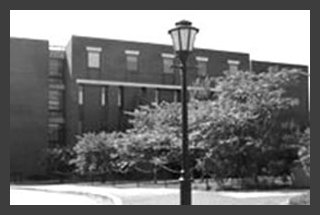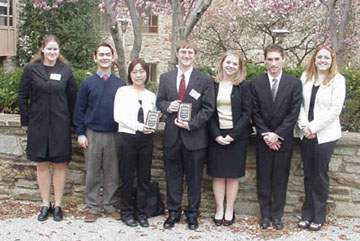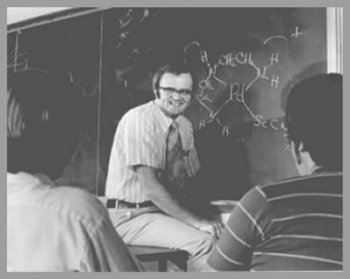| Number 28 |
John L. Burmeister, Editor |
August, 2001 |
FROM THE ASSOCIATE CHAIR: THEN AND NOW
Recently, I had occasion to present a brief retrospective overview
of our undergraduate program to our new Interim Dean of the College
of Arts and Science, Dr. Mark Huddleston. The comments that I have
subsequently received from several quarters have prompted me to
expand on that theme for this year's Blue Hen Chemist.
The frame of reference that I have chosen is a comparison between
my first year as Associate Chair (1974-75) and the year just completed.
 Not surprisingly,
our faculty was smaller then (24) than it is now (31, going up
to 35 this fall). Far more impressive is the large degree of turnover.
Of the eleven full professors active in 1974-75, only four remain
(Bob Wood, John Burmeister, Burnaby Munson, and Roberta
Colman). One (Harold Kwart) passed away while still
a full-time faculty member, three (Harold Beachell, Sy Yolles,
and Jim Moore) retired and subsequently died, and three
others (John Wriston [now teaching again part-time], Dick
Heck, and Ed Schweizer) are living in retirement. The
turnover at the associate professor level has been even more dramatic.
Only Tom Brill remains. Joe Noggle died while active;
Wally McCurdy, Conrad Trumbore, Carl von Frankenberg, and
Don Dennis have all retired. Only three members (Hal
White, Doug Ridge, and Mahendra Jain) of the 1974-75 assistant
professor squad are still U of D faculty members. Wayne Anderson
is now a professor of chemistry at Bloomsburg (PA) University.
Henry Blount is the head of the Office of Multidisciplinary
Activities in NSF's Directorate for Mathematical and Physical
Sciences. Roger Murray is the chair of St. Joseph's University's
Chemistry Department. The current position of Robert Curry
is unknown. Burnaby Munson was in his second (and last)
year as Acting Chair. His Assistant to the Chair was the legendary
Joe Camperson. We also had a chemist in the upper administration
(Arnold Lippert was the Dean of the College of Graduate
Studies). Not surprisingly,
our faculty was smaller then (24) than it is now (31, going up
to 35 this fall). Far more impressive is the large degree of turnover.
Of the eleven full professors active in 1974-75, only four remain
(Bob Wood, John Burmeister, Burnaby Munson, and Roberta
Colman). One (Harold Kwart) passed away while still
a full-time faculty member, three (Harold Beachell, Sy Yolles,
and Jim Moore) retired and subsequently died, and three
others (John Wriston [now teaching again part-time], Dick
Heck, and Ed Schweizer) are living in retirement. The
turnover at the associate professor level has been even more dramatic.
Only Tom Brill remains. Joe Noggle died while active;
Wally McCurdy, Conrad Trumbore, Carl von Frankenberg, and
Don Dennis have all retired. Only three members (Hal
White, Doug Ridge, and Mahendra Jain) of the 1974-75 assistant
professor squad are still U of D faculty members. Wayne Anderson
is now a professor of chemistry at Bloomsburg (PA) University.
Henry Blount is the head of the Office of Multidisciplinary
Activities in NSF's Directorate for Mathematical and Physical
Sciences. Roger Murray is the chair of St. Joseph's University's
Chemistry Department. The current position of Robert Curry
is unknown. Burnaby Munson was in his second (and last)
year as Acting Chair. His Assistant to the Chair was the legendary
Joe Camperson. We also had a chemist in the upper administration
(Arnold Lippert was the Dean of the College of Graduate
Studies).
Only two (BS/CHEM, BA/CHEM) of our current five undergraduate
degrees were offered in 1974-75. The University Honors Program
had not yet been initiated. Our total UG major count was 176 in
75F, versus 235 in 00F. The class of 1975 (40) was considerably
smaller than the class of 2001 (58). Only 25% of the former
were females (3/22 BS, 7/18 BA), versus 47% today.
In 1975, only three CHEM/BIOC departmental awards were presented
on Honors Day: Elliot I. Band, Ph.D. (BS75, with Highest
Honors; now Technical Development Manager for Akzo Chemicals in
Dobbs Ferry, NY) received the AIC Award, D. Steven Mackey (BA78,
current position unknown) was selected for the ACS Award, and
Karen Hyatt Stump (BS76, currently Director of Laboratories for
Carnegie-Mellon University's Chemistry Department) was the recipient
of the Drake Scholarship. In contrast, seventeen CHEM/BIOC
departmental awards were presented on Honors Day this year, and
are shown elsewhere in this Newsletter.
However, the class of 1975 was, by no means, lacking for honors.
The late Bruno E. Basara, Jr., M.D. (BS75, with Highest
Honors) received the Governor's Award as the top graduating senior
in the entire University, thanks to his 4.000 GPA. Mary Anne
Facciolo, M.D. (BA75, with Highest Honors; now in private
practice in Baltimore) was the Arts and Science representative
on the Panel of Distinguished Seniors. Keith E. Senecal, M.D.
(BA75, with Highest Honors; currently an emergency medicine physician
in the Chambersburg (PA) Hospital) was presented the Intercollege
Paynter Memorial Prize. In addition, James F. Koch, M.D.
(BS77, now a physician in Wilmington) was honored with the Phi
Beta Kappa Award.
Remarkably, 21 of the 40 members of the class of 1975 graduated
with Honors [Gary E. Albright (art conservator with the
George Eastman House in Rochester, NY), Bro. Peter N. Bunitsky
(BA, deacon with the Saints Sergius & Herman Orthodox Church in
Wilmington), Barbara A. Dennison, M.D. (BA, epidemiologist
in Cooperstown, NY), Robert A. Jacobs (BA, senior pharmacist
with Rorer Pharmaceuticals in Ft. Washington, PA), Deborah
Keller Vickery (BA, staff writer with Technical Writers, Inc.
in Wilmington), Donald A. Piel (product manager with Occidental
Chemical Co. in Dallas, TX), Paula A. Sherman, Ph.D. (research
scientist with Glaxo SmithKline in Research Triangle Park, NC),
and Evan C. Speck, M.D. (physician in Evansville, IN)];
High Honors [William J. Calhoun, M.D. (associate professor
of medicine at the University of Pittsburgh), John T. Hurley,
M.D. (radiologist in Rochester, NY), David J. Miner, Ph.D.
(director of regulatory project management with Eli Lilly in Indianapolis,
IN), Linda J. Pike, Ph.D. (professor of biochemistry at
Washington University, St. Louis), and Patrick J. Rafferty
(manager of environmental health and safety with Clayton Environmental
Consultants in Downingtown, PA)]; or Highest Honors [William
E. Barnette, Jr., Ph.D. (research supervisor with DuPont Agricultural
Products in Wilmington), Thomas S. Pattison, M.D. (physician
in El Macero, CA), Michael X. Repka, M.D. (BA, pediatric
opthamologist with the Johns Hopkins Childrens Center, husband
of Mary Anne Facciolo), Mark D. Vuolo, M.D. (BA,
physician in Casper, WY), plus the four listed previously].
Perhaps the greatest difference between the classes of 1975
and 2001 was in the extent of their research involvement. None
of the former graduates received a Degree-with-Distinction, which
requires the writing and successful defense of an original research-based
thesis. In contrast, a whopping ten members of the latter
class received Degrees-with-Distinction! (Read all about them
at
(www.udel.edu/chem/white/UCC/UD-CHBC-UgRes01.html). Only three
U of D students presented research papers at the 1975 Intercollegiate
Student Chemists Convention, held at your Editor's alma mater,
Franklin and Marshall College. All three received awards for their
presentations: Barbara Dennison (2nd prize,
Biochemistry), Jerome R. Lenhard (2nd prize,
Analytical; now a chemist with Eastman Kodak in Rochester, NY),
and Mary E. Torkelson (2nd prize, Physical;
now in technical sales with the Upjohn Co. in Kalamazoo, MI).
The seven U of D presentations at this year's ISCC produced two
awards, as noted elsewhere in BHC #28. The marked difference
in research involvement may be traced, in large measure, to our
acquisition of both institutional (Department Science Scholars)
and external (Howard Hughes Medical Institute Undergraduate Research
Fellows) support for full-time undergraduate research stipends
during the summer and/or winter sessions. Sixteen of our majors
participated in these programs during the past year.
 |
[Students attending the 2001 Intercollegiate
Student Chemists Convention:
Valerie Dzubeck, Isaac Hubner, Candy Tong, Adam Hock, Laura
Tolen, Tony Scarpaci, Nikki Goodwin] |
The most surprising difference between the two eras will be found
in their respective total undergraduate enrollments in CHEM courses.
Given the larger current size of the University, one would expect
a larger CHEM undergraduate enrollment in 2001. Quite the opposite
is true: 74F, 3090; 75S, 2642; 00F, 2656; 01S, 2089. The diminution
is due to the fact that a significant number of our user departments
do not consider the "Central Science" to be as central to their
needs as it once was. For example, nursing's CHEM requirement has
been cut from 16 to 9 credits, while those of civil, electrical,
and mechanical engineering have been reduced from 8 to 4 credits.
Even chemical engineering, which required 24 CHEM credits of its
majors in 1974-75, now only requires 19 credits.
Four current staff stalwarts were already serving the Department
well in 1974-75: George Rutynowski (in the Machine Shop),
Jim Cleaver (in the Electronics Shop), Susan Crossan
Ridgway James (then a stenographer, now administrative assistant
to Cathy Skelley, current assistant to the chair), and
Susan Baker Cross Cheadle (then a stenographer, now a staff
assistant). Walter J. Freeman (PhD72, retired vice-president
of Hercules, Inc.) was the Department's NMR spectroscopist. Dr.
Barbara Jelus was in a parallel position in mass spectrometry.
Charlotte Hoffman was what we now call our manager of laboratory
services. The also legendary John Ferrante was in charge
of the chemistry stockroom.
Our physical plant's footprint was considerably smaller in 1974-75.
Indeed, Quaesita Drake Hall had just been dedicated on November
17, 1973, and was already leaking severely!
Visible evidence of the change created by the passage of 27
years will be seen in the accompanying picture of your Editor
at work in 1974.
And the beat goes on!
- John L. Burmeister -

[John Burmeister - 1973
(Foreground: Gary Weddle (Ph.D. 76), Richard Marchese (BS 73)]
|